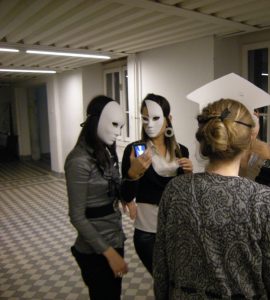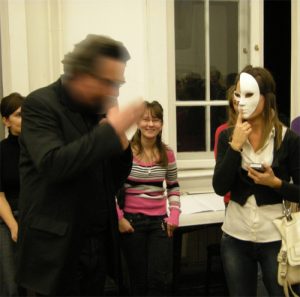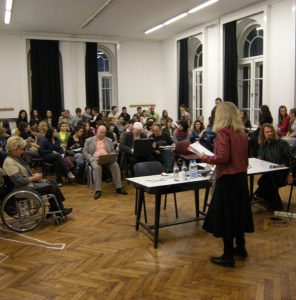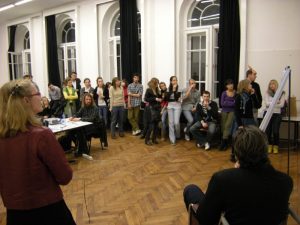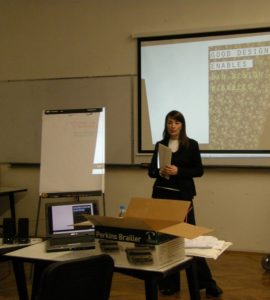accesibility for people with disabilities
ACCESSIBILITY OF THE ARCHITECTURAL SPACES FOR THE PEOPLE WITH DEVELOPMENTAL DISABILITI
The workshop was as part of the Sustainability Conference in Belgrade; it was organized on Friday, November 11th at the Faculty of Architecture University of Belgrade (Bul. Kralja Aleksandra 73/II) in the room 218 (2nd floor) from 16.00h until 20.00h.
Workshop hosts:
Zoran Djukanovic, Vice Dean and Assistant Professor
Goran Radulovic, Coordinator of international relations
International relation office of Faculty of Architecture, University of Belgrade
Workshop tutors:
Gunnel Bergström, freelence journalist from Sweden
Fredrik Stockhaus, Swedish Handicap International from Belgrade
Vesna Bogdanovic, Inclusive Society Development Center (CRID)
Sasa Bogdanovic, Inclusive Society Development Center (CRID)
Miodrag Jankovic, School for visually impaired children in Zemun-Belgrade
Dalibor Sipka, School for visually impaired children in Zemun-Belgrade
Dragana Ognjenovic, fashion designer from Belgrade
40 students of Faculty of Architecture University of Belgrade participated in this workshop.
On the initiative and with the help of Sweden Embassy in Belgrade, and with the help from the Secretary of Education of the City of Belgrade, European Centre for Culture and Debate “Grad”, program “Public Art & Public Space”, program “Moj Stočić” and the others; along with the participation of eminent experts from Sweden and Serbia, Faculty of Architecture University of Belgrade is organizing the workshop “Accessibility for people with disabilities” – “Accessibility of the architectural spaces for the people with developmental disabilities”.
Freelance journalist Gunnel Bergström from Sweden was the initiator and the moderator of this workshop. She teaches Swedish at the universities in Riga, Latvia, and Kaliningrad, Russia. She shared her experience from being a supportive member of Forum Women and Disability in Sweden, FQ, which brings together women with all kinds of disabilities, like hearing disabilities, visual impairments, mental disabilities (e.g. panic syndrome), physical disabilities, eating disorders, allergy and asthma (try breathing through a straw!), here own experiences with small children (her own godson Mikael) with brain damage through an infection, etc.
The main speaker was Fredrik Stockhaus from Swedish Handicap International. He is a Regional Programme Coordinator, working in Belgrade since 2007 with advocacy and support to DPOs (Disabled People´s Organisations) for Handicap International South Eastern Europe. Fredrik Stockhaus told the audience about his work with local disability action plans in 24 municipalities in countries in the Balkans, work on local disability action plans (LDAP) that are based on the UN Standard Rules for Equalization of Opportunities for People with Disabilities. He also pointed to the clear link between accessibility and policy. Without a policy that defines how you have to work it will be impossible to achieve accessibility. You need to know how the situation looks like and you need to set up very concrete and measurable aims in order to be able to follow the development.
The crucial questions are: how the situation is like now, what needs to be done in order to improve it, where should we start working and why, who should be involved, what will the budget be, who will monitor the development, and how should we evaluate the results afterwards? The LDAP requires active citizens, DPOs, politicians and officials. It requires that disability is seen as a Human Rights issue. Accessibility is a question of Human Rights since it is the precondition for the free movement of large groups in society, and the full participation of all citizens in society requires full accessibility.
The next speakers were Vesna and Sasa Bogdanovic from the NGO “Inclusive Society Development Center (CRID) who presented “Design for all“ movement/principles. They showed persuasive slides with moto “Good design enables, Bad design disables”. They also discussed on who and what is “normal” issues.
Practical and fresh approach of taking design as a tool for proper integration of children with disabilities was presented by famous Serbian designer Dragana Ognjenovic, the Head of the the project Moj Stocic (My little table) where children design cards, make animals and many other forms of handicraft.
Final speakers were Miodrag Jankovic and Dalibor Sipka, teachers from the “Veljko Ramadanovic” School for visually impaired children in Zemun/Belgrade.
Miodrag Jankovic talked generally about the Veljko Ramadanovic School and their activities and approach in work with students.
Dalibor Sipka showed some of the assistive technology and computer adaptations such as synthetic speech software and magnification software used by people are visually impaired.
DEFINING ACCESSIBILITY IN PRACTICE
After the lectures, students started small discussions in ”bee hives” (two and two) to answer some questions about accessibility: What? Why? How?
Some of the disabilities the students came up with were: deaf, hard of hearing, blind, visual impairment, physical disabilities, and mental disabilities (and Fredrik asked if there could be two kinds – intellectual and psychosocial disabilities? Respiratory diseases like asthma and allergy, eating disorders (you may have very disobedient stomachs and intestines, and need to find a toilet within a second. This disability is not visible, and you get a lot of suspicion from people at your work, if you are too tired one day to come, and the other days are looking perfectly fine…
One important conclusion was that architecture needs a graduation system for accessibility, just like hotels. The goal would be to achieve * * * * * (five stars).
TERMINOLOGY
What terms do we use, what do they mean?
Invalid – is it a person who is not valid?
Vesna Bogdanovic from CRID started a brainstorming and a discussion about terminology. The students came up with a lot of ideas about the terms handicap, invalid, cripple, person with special needs, the handicapped, those disabled ones, mentally retarded, bound to a wheelchair, bound to the bed…
The further discussion addressed questions like: Why is the terminology important? What difference does it actually make?
CHECK THE ACCESSIBILITY
The last but maybe the most interactive part of the programme was the final students´ work in groups. They put on provided theatre masks and set off for checking the accessibility of the Building of Technical Faculties.
Their equipment was: a wheelchair, blind folds and white canes, ear plugs, and a common sense.
In their presentations, they summarized what they have discovered, for instance:
Slippery floors, very steep wheelchair ramps and some parts of the Faculty building that are not accessible at all for persons in wheelchairs. If a person is blind, he/she may bump in to the sculptures Dobrovic and Zlokovic (Good and Bad) and hit your head. There were also comments on insufficient illumination, narrow passages, lack of elevators, etc.
Visiting workshop tutors found that majority of students have deep skills on architecture, as their presentations were pretty direct and concrete in terms of necessary architectonical changes and adaptations. Gunnel Bergström, the workshop moderator gave their work ***** and said: “You are all Dobrovic!”
different needs
People have different needs.
If you are deaf and want to communicate with hearing people, you probably need a sign language interpreter. If you are hard of hearing, you will need a teleloop in a classroom, during a conference or lecture. If you are blind, you need the literature to be available in braille, via computer and/or recorded. If you are visually impaired, you need different kinds of glasses. And a xxxx to take notes. As we grow older, we realize more and more about our needs for accessibility for all. Young planners and architects should keep this in mind and in their backbone prior they start designing a house, a flat, an official building, a park, etc.
Not to forget – safe elevators.
And we always need each other!
DECEMBER 3, 2009
INTERNATIONAL DAY OF PEOPLE WITH DISABILITIES
Zoran Djukanovic wrote the following words after our workshop, on 3 December
Today is the International Day of People with Disability.
I have a dream…
I have a dream that one day it will not be necessary to point out this kind of day.
We cannot walk alone…
Wantonness is the biggest handicap.
Think about that.
Zoran Djukanovic
Danas je Medjunarodni dan osoba sa invaliditetom.
Sanjam…
Sanjam dan kada vise necemo imati potrebe da obelezavamo ovaj dan.
Mi nismo sami…
Bezobzirnost je najveci hendikep.
Mislite o tome.
Zoran Djukanovic
accesibility for people with disabilities / Gallery
